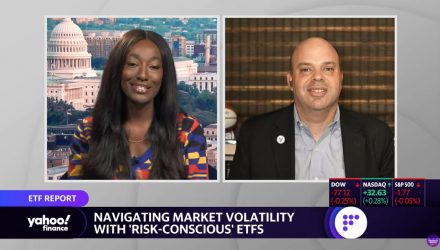Markets tanked yesterday on the release of August’s consumer price index report that revealed a 0.1% month-over-month rise in broad inflation in August on expectations of a decline, with core CPI (excluding food and gas) gaining 0.6% over the same period. Todd Rosenbluth, head of research at VettaFi, appeared on Yahoo Finance’s “ETF Report” to discuss risk-conscious investing options for advisors in a volatile market.
The major indexes closed down yesterday on their worst day since June 2020, bringing a four-day relief rally to an abrupt end. Volatility is a continuing trend for U.S. markets this year as equities and bonds both feel the squeeze from persistent inflation and rising interest rates.
“If the market volatility that we saw yesterday, and perhaps even throughout 2022, is causing angst for advisors and investors, then they really need to make sure that they’re in the lower-risk strategies that are out there,” Rosenbluth said.
The S&P 500 fell more than 4% yesterday after the release of the latest CPI report, but the Invesco S&P 500 Low Volatility ETF (SPLV) that tracks 100 of the least risk-oriented companies within the S&P dropped less (-2.84%) due to its more defensive tilt towards sectors such as utilities and consumer staples.
The iShares MSCI USA Min Vol Factor ETF (USMV) is another fund that seeks to mitigate volatility, but it has exposure to more risk-on sectors such as technology and consumer discretionary that SPLV does not and therefore was down more than SPLV at -3.19% but still performed better than the broader index.
“These are the two most popular of these lower-risk equity ETFs, but investors should be favoring these as opposed to just riding the wave of the market volatility and then being concerned about what happens after the fact,” Rosenbluth said.
Rosenbluth went on to explain that the time to be invested into low-volatility strategies is ahead of market sell-offs versus reacting to volatility.
.@Vetta_Fi Head of Research @ToddRosenbluth on navigating market volatility with ETFs: “Investors should be favoring [lower-risk equity ETFs] as opposed to just riding the wave of the market volatility and then being concerned about what happens after the fact.” pic.twitter.com/WekK3fhgRB
— Yahoo Finance (@YahooFinance) September 14, 2022
Better Defined Outcomes
For investors with a time horizon that makes them more concerned with the downside of markets currently, Innovator ETFs offer a suite of products that can help control that downside through its defined outcome and buffer funds.
One such fund is the Innovator U.S. Equity Power Buffer ETF – September (PSEP), which seeks to reduce and mitigate the downside but also caps the upside potential, allowing investors the chance to define better the risk and reward parameters they are comfortable with over a 12-month time period.
“These are best used for at least 12-month time horizons because that’s what the buffer is set for, but you can hold onto these ETFs for more than 12 months and continue to roll this forward over 24, over 36 months,” Rosenbluth said. “These defined outcome ETFs can make it much easier instead of trying to have your emotions play it for you, you’re able to control your destiny with this ahead of time.”
Another investment alternative in a challenging environment of market volatility is the Pacer Lunt Large Cap Alternator ETF (ALTL), which rotates its exposures based on high beta and low volatility options. It’s a good play for advisors concerned about missing any potential upside from markets while also looking to define their exposures better.
Bond Investing Remains Short-Sighted
On the bond side, advisors remain concerned about rising rates and duration risk.
“We heard from advisors last week where what they told us is they were expecting the Federal Reserve to be raising interest rates into 2023 and remaining elevated, and so they’re more comfortable towards shorter-term bond ETFs,” explained Rosenbluth.
One such ETF is the Vanguard Short-Term Corporate Bond ETF (VCSH), which provides credit market exposure without taking on high-interest rate sensitivity.
For more news, information, and strategy, visit the Innovative ETFs Channel.








